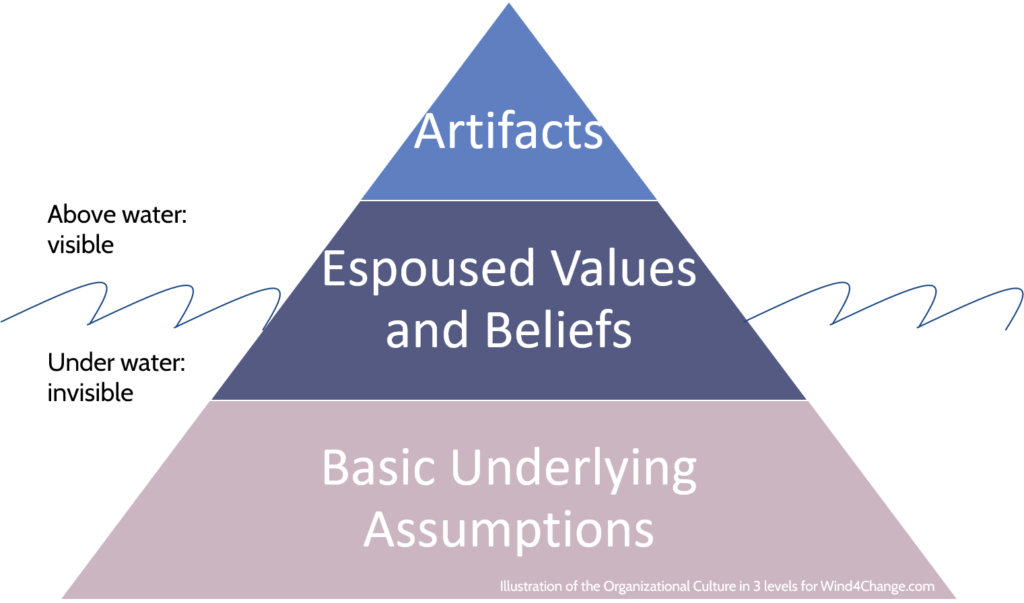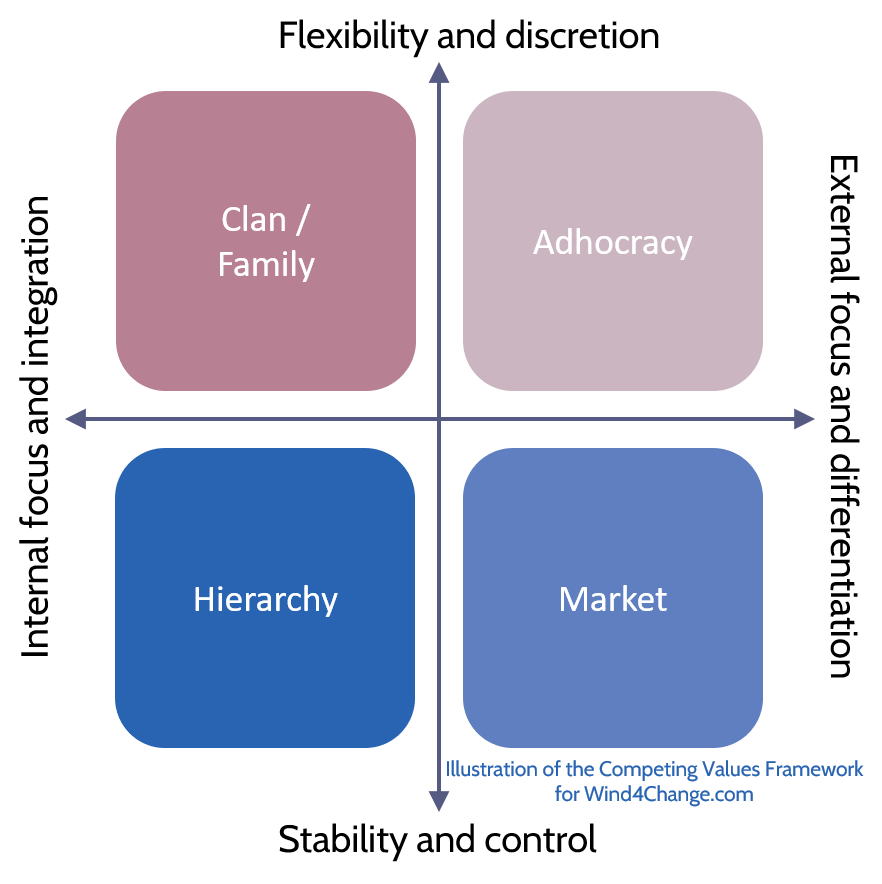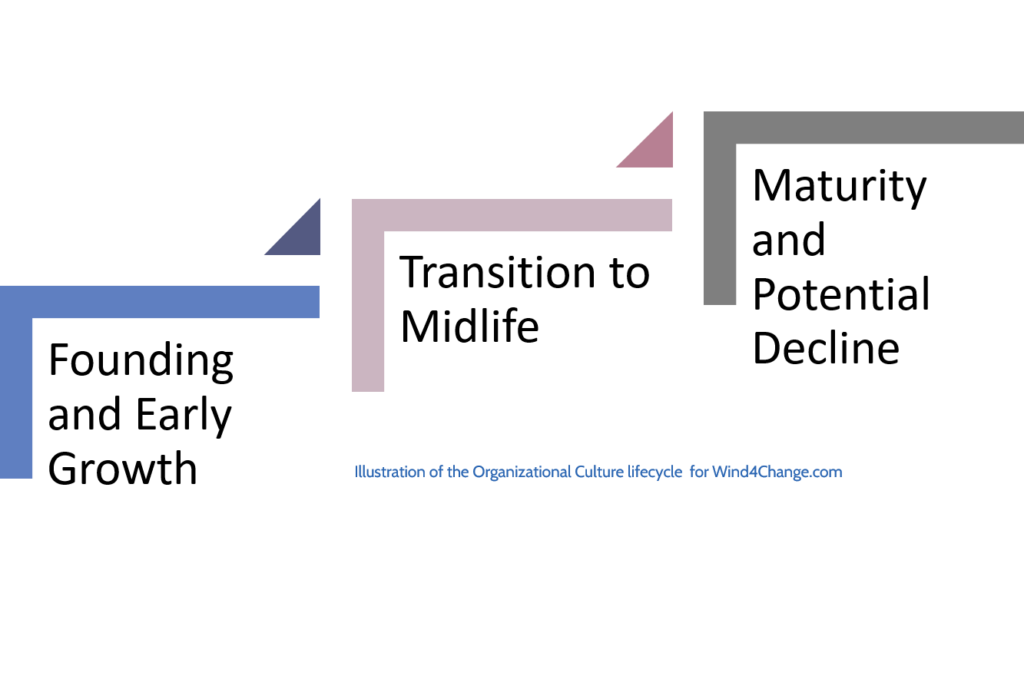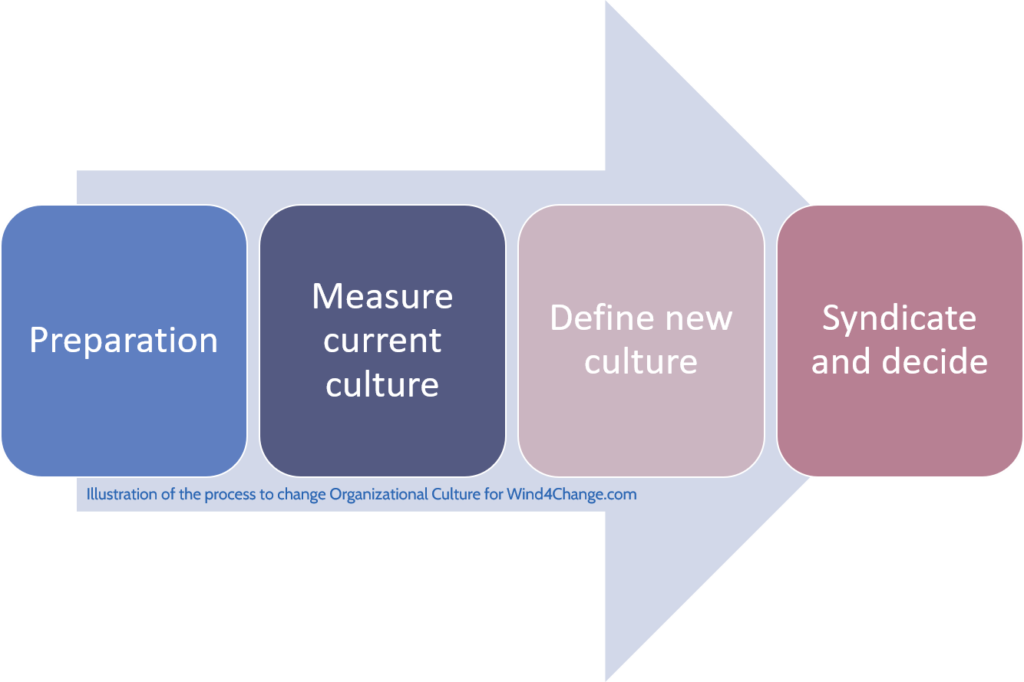Organizational culture can be defined in three levels: artifacts, the tangible part of the culture like rituals, climate and language, the espoused beliefs and values that is an intangible part but conscious and still partially observable, at last, the basic underlying assumptions that is an intangible part, unconscious and cannot be directly observed.
- What is Organizational Culture and how it forms
- Organization Culture vs Subculture
- What are the 4 types of Organizational Culture
- How organization culture changes as the organization grows
- Macro culture
- Organizational Culture and Leadership
- Can Organizational Culture be measured and changed ?
- What’s next? Learn more about Change Management and discover Coaching
- Do you want to learn more Organizational Culture and Leadership? Here are some valuable references
What is Organizational Culture and how it forms
In Organizational Culture and Leadership, Edgar H. Schein defines the culture as follows:
The culture of a group can be defined as the accumulated shared learning of that group as it solves its problems of external adaptation and internal integration; which has worked well enough to be considered valid and, therefore, to be taught to new members as the correct way to perceive, think, feel, and behave in relation to those problems. This accumulated learning is a pattern or system of beliefs, values, and behavioral norms that come to be taken for granted as basic assumptions and eventually drop out of awareness. […] Culture is ultimately a characteristic of a group, just as personality and character are ultimately characteristics of an individual.
How Organizational Culture is formed
Organizational Culture is formed as a group of people adapts to its environment and integrates then grows to become an Organization. To illustrate, with shared successes but also failures, the organization develops its beliefs and values that shape the culture and define all artifacts in the organization. With time, the Organizational Culture consolidates, stabilizes and spreads all over the organization. In other words, it defines the organization.
Why Organizational Culture matters
Organizational Culture is everywhere in all human activities and related artifacts. You can observe it as a consistent system in rituals, patterns of interaction, language and also in the result of human activities like processes, structures of the organization. Moreover, Organizational Culture is often captured as values or principles in an Organization Chart.
Clearly, Organizational Culture is pervasive and influences all aspects of how the organization works, either internally and externally with its environment. Furthermore, it impacts its objectives and how the organization achieves them.
At last, Organizational Culture is to take into account when changing the organization. Surely, a transformation will fail if it is not consistent with the organization culture.
How the Organizational Culture framework defines culture in three levels
Edgar H. Schein describes the Organizational Culture over 3 levels: artifacts, espoused beliefs and values, and at last, basic underlying assumptions. To illustrate, it is a little bit like an iceberg with some levels visible, some others partially or not visible.

Artifacts
You can see or feel the cultural artifacts. They are the visible part of the iceberg. But if you can observe them, they may be difficult to decode. For instance, cultural artifacts are:
- Formal rituals and celebrations.
- Interaction patterns.
- Language with shared meanings and root metaphors.
- Structures: how the organization is organized, including the physical space.
- Processes and policies.
Organizational Culture versus Climate
If climate is a part of culture, it is not the culture but a demonstration of the culture. In other words, climate is a cultural artifact.
Espoused Beliefs and Values
Organization publicly communicates beliefs and values when they are espoused, like Company Charter. They are the part of the iceberg that is for a part visible and for the other part hidden.
To illustrate, Espoused Beliefs and Values are:
- Values and beliefs themselves, sometimes expressed as or illustrated by stories.
- Vision and goals.
- Mental models.
- Group norms.
Espoused Beliefs and Values form through the experience as people in the organization test them. Truly, if they keep working in solving problems, they will get stronger and may even transform into the third level, the basic assumptions.
However, some Espoused Beliefs and Values cannot be tested and require a social consensus to grow or transform into basic assumptions. To clarify, this is because members of the Organization reinforce each others’ beliefs and values, that a social consensus emerges.
As the link between the strategy and the performance may be difficult to prove, Edgar Schein puts strategy and goals in non testable beliefs and values.
Note that espoused beliefs and values may or may not be consistent with artifacts. Indeed, they may be a difference between what is said and what is done. Clearly, the third level, the basic assumptions, may interfere with espoused beliefs and values and may generate different than expected behaviors or other artifacts.
Basic Underlying Assumptions
Basic Underlying Assumptions are unconscious and taken-for-granted beliefs and values. They are the hidden part of the iceberg. For example, they are so strong that members of the Organization will consider some behaviors not consistent with these Basic Underlying Assumptions as inconceivable.
As a result, they are extremely difficult to change as they are non-confrontable and non-debatable. Furthermore, trying to change Basic Underlying Assumptions generates a lot of stress as it destabilizes the cognitive and interpersonal models of the members of the organization. As a consequence, people tend to distort or deny what happens around them so events are consistent with their assumptions.
Culture is the identity of the organization
Culture provides its members with a basic sense of identity. Indeed, it tells its members who they are, how to behave between each other and what makes them feel good about themselves.
Organization Culture vs Subculture
Within an organization, subcultures may emerge depending on the specificities of some perimeters. Parameters generating subcultures are:
- Functions or profession, including core activities like Operators (run and interaction), Designers (design and knowledge), and Executives (finance and interaction with stakeholders).
- Geography.
- Differentiation by Product, Market, or Technology.
- Hierarchical Level.
It is important to align and integrate subcultures to enforce consistency. Really, failing to do so and the different parts of the organization will not be able to properly work together.
What are the 4 types of Organizational Culture
The 4 types of Organizational Culture, also named the Competing Values Framework, was invented by Robert Quinn and John Rohrbaugh from the University of Michigan in 1983.
This model defines the culture based on a matrix of 2 dimensions:
- Stability and control vs Flexibility and discretion.
- Internal focus and integration vs External focus and differentiation.
Each organization has a dominant type, even if subcultures may fall in different types.

The 4 types of Organizational Culture
Hierarchy culture
- It is a control culture: control and efficiency with process and structure as levers.
- Also, it is the traditional command and control culture with processes, rules, clear roles and strong hierarchy. It is efficient to manage risk and operational efficiency in a stable environment. Drawback is that it lacks flexibility and it lowers the capacity for innovation.
Market culture
- It is a competitive culture: results and market oriented with competition and customer focus as levers.
- It has a strong external focus on profits and on beating the competition. Surely, innovation is important but the control aspect hinders it. This is the culture of traditional consumer product companies. In this type of culture, people come as a secondary concern, so high expectations put them at risk to burn out.
Clan or family culture
- It is a collaborative culture: people-oriented with human participation and development as levers.
- It happens in small or family-owned businesses with little hierarchy by nature and a friendly environment. As a result, collaboration and mentoring are high and people feel comfortable with open and candid feedback as an illustration. Growing an organization with this culture is a challenge.
Adhocracy culture
- It is a creative culture: dynamic and entrepreneurial with vision and innovation as levers.
- The name is the combination of ‘Ad hoc’ and bureaucracy. To clarify, it is a culture that is not inhibited by bureaucratic policies and processes. This is the culture of start-up and tech companies where pace, innovation and improvement are high to face a fast changing and competitive market.
How organization culture changes as the organization grows

Founding and Early Growth
In this early stage, the organization differentiates from its environment and from other organizations. The organizational culture emerges all the more faster, that the founders are still present, and that the organization has to struggle with its environment to survive. Surely, the harder the experience, the stronger the lesson learned, therefore the culture. Furthermore, selecting new comers or teaching them the new culture reinforce the developing culture.
Common changes of the culture at this stage include higher integration, growing complexity and diversification.
The market area also has an impact on the emerging organization culture with its dominant skill. For example, high tech companies will have strong research and development (R&D) skills, whereas consumer product companies will develop solid marketing skills.
Transition to Midlife
At this stage, founders usually have transferred the control of the organization to general managers. As a consequence, conservatives to the founding culture and liberal in favor of the new culture may confront to keep or enhance their power. Actually, selecting and bringing outsiders into manager positions, at different levels, is a way to stimulate a culture change.
Furthermore, the culture is now embedded in artifacts like processes and organizational structures to such an extent that most pieces of it become taken for granted. As a consequence, conscious elements reduce to espoused values, company moto and charter.
In addition, diversity of subcultures keeps growing. In midlife, they are not a threat any longer but a factor of stability. Nevertheless they are a limitation to change.
Organizational Maturity and Potential Decline
At this stage, organization experience and values validation anchor the culture and hinder more the capacity to change:
- Many basic assumptions take root.
- Organization develops espoused values and beliefs increasingly distant from the actual assumptions by which they operate.
- It also formulates positive myths about how it operates, to illustrate: a self-image, a sort of organizational face.
Macro culture
Organization culture also applies to organization that are much bigger than companies like countries or professions. What Edgar Schein calls macro culture.
Macro cultures are nations, ethnic groups, and occupations that have been around for a long time and have, therefore, acquired some very stable elements, or “skeletons,” in the form of basic languages, concepts, and values.
The structure of the organization culture still applies to Macro cultures. If we come back to the 3 levels of culture, the split for a country and a profession as macro culture would be:
- The artifacts level is:
- What tourists encounter when they travel to a country.
- What somebody experiences when going to the doctor.
- The espoused-values level is:
- The ideology of the country usually around politics or economics like Social Democracy or Liberalism.
- The official mission statements of the medical profession.
- The basic assumptions are everything that is hidden, taken from granted and generates gaps between espoused values and beliefs and actual behaviors or other artifacts.
Hofstede’s Culture Model
There are several cultural frameworks to study culture at macro level. Hofstede’s Culture Model is one of them. It has 5 basic dimensions:
- Individualism vs Collectivism: how much a macro organization is built around the individual or on the contrary around the group where individuals merge in the collection.
- Power Distance: how big is the distance in the organization between the highest and lowest powered people in terms of social and psychological status.
- Masculinity vs Femininity: how much the gender roles are differentiated.
- Tolerance for Ambiguity and Uncertainty: how much members of the organization feel comfortable in uncertain and ambiguous context. This is revealed by a lack of process, rule or structure.
- Short-Run vs Long-Run Time Orientation: how much members of the organization think and plan the future or on the contrary focus on the near term.
Organizational Culture and Leadership
Edgar Schein stresses that the core role of leadership is to management of culture. Surely, they have the responsibility to shape and develop the culture during all life of the organization, so it supports its growth and capacity to adapt to its environment. In addition, the culture they foster should be comfortable for employees to thrive. Really, this has also an impact on how motivated and performant they are.
The paradox of culture at maturity stage is that now the culture defines the management. Indeed, once established, the culture sets and enforces criteria to promote leaders. As a result, this requires leaders extra efforts to change the culture, sometimes with a the board bringing in a “turnaround CEO” with primary mission to transform the culture of the organization.
How leaders embed and transmit culture
Leaders embed and transmit culture with primary behavior and secondary mechanisms.
Primary mechanisms to change the culture: Leaders’ behaviors
Leaders influence the organization culture with:
- Leader focus:
- What they pay attention to, control and request measure about.
- How they react to critical incidents and crises.
- At last, how they allocate means.
- Leader role modeling:
- What they teach and coach.
- But above all, how they behave: do their behaviors demonstrate what they ask for? There is nothing more destructive than inconsistency between leaders’ behavior and narrative.
- Leader rewards:
- How leaders allocate rewards and status.
- Also, how leaders recruit and promote.
Secondary reinforcement and stabilizing mechanisms
Leaders also impact the organization culture with:
- The organization structure they implement and the related physical space.
- The procedures they define.
- The rituals they establish.
- The stories they contribute to develop and spread.
- The company charter that capture values and beliefs.
Can Organizational Culture be measured and changed ?
Edgar Schein proposes an approach to measure and change the Organizational Culture.

Preparation of the Organizational Culture Change
The first step is the preparation of the transformation.
- Start by defining with leadership the letter of mission, the objectives of the transformation and the expected impact.
- Then select the groups for the assessment. Make sure that they are representative of the different subcultures of the organization and that they will be perceived as such.
- At last, explain the groups about the organization culture and its 3 levels.
Measure the Organizational Culture
For each group, conduct a workshop in order to capture the Organizational Culture over its 3 levels:
- Artifacts:
- Ask the group to identify as many as possible artifacts of their organization, then collect them and sort them on a visual.
- Espoused Values and Beliefs:
- Ask the group to identify their espoused values and beliefs and have the group match them with the artifacts identified on the visual.
- Are they consistent?
- Investigate 2 first reasons to explain inconsistencies:
- Subculture of the group.
- Lack of consensus, in other words, the value is not really anchored.
- Basic Assumptions:
- Dig inconsistencies still to explain with the Basic Assumptions: what deeper assumptions may explain the artifacts?
Define the new Organizational Culture
This stage structures over 3 steps coming back to the objective of the culture change:
- What are the transformation objectives and the expected impact?
- How does the current culture support or hinder the change?
- What is the transformation to conduct for the pieces of current Organizational Culture that are a limitation?
- Check that the change is not too far from the current Organizational Culture. This may ask for a change of strategy or to slice the transformation in phases.
Syndicate and decide about the Organizational Culture
To complete this framing:
- Get a consensus about leaders and people of influence about the new Organizational Culture and the major changes it requires.
- Decide about the next steps to kick-off the transformation.
What’s next? Learn more about Change Management and discover Coaching
- Discover my other posts on the change model and the different roles in coaching like teaching, mentoring and coaching.
- Review also my post on how to deliver a brain-friendly training as described in the approach “Training from the back of the room“.
- Find all the posts about Change Management here and about Coaching here.
Do you want to learn more Organizational Culture and Leadership? Here are some valuable references
- Organizational Culture:
- The book Organizational Culture and Leadership from Edgar H. Schein.
- A good post from Harvard Business Review.
- The 4 types of culture:
- A good post from Academy to Innovate HR.
- Another relevant post from JobStreet.com.
- Example of ideologies from helpfulprofessor.com.
